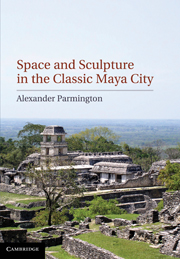Book contents
- Frontmatter
- Contents
- List of illustrations
- List of tables
- Summary
- Acknowledgements
- Introduction
- 1 Defining the Maya built environment
- 2 Investigative considerations and methodology
- 3 Access analysis of the Palenque Cross Group and its sculpture
- 4 Architectural and sculptural programs of the Palenque Palace Group
- 5 Access analysis of the architectural and sculptural programs of the Palenque Palace Group
- 6 Access analysis of Maya art and architecture: Summary and conclusions
- Appendixes 1–7
- Bibliography
- Index
1 - Defining the Maya built environment
Published online by Cambridge University Press: 05 August 2011
- Frontmatter
- Contents
- List of illustrations
- List of tables
- Summary
- Acknowledgements
- Introduction
- 1 Defining the Maya built environment
- 2 Investigative considerations and methodology
- 3 Access analysis of the Palenque Cross Group and its sculpture
- 4 Architectural and sculptural programs of the Palenque Palace Group
- 5 Access analysis of the architectural and sculptural programs of the Palenque Palace Group
- 6 Access analysis of Maya art and architecture: Summary and conclusions
- Appendixes 1–7
- Bibliography
- Index
Summary
Architecture, space, and cognition
Since ancient times, cities and towns have incorporated dominant architectural features as a means of signaling the priorities of civic and/or elite populations, as a way of making apparent the hierarchy of popular or imposed institutions, whether religious, governmental, or technological in nature. Often it has been architectural features, such as the degree of decoration displayed on buildings, combined with the relative size of functionally specific structures, that have been used as a way of signaling this order of priority, where building size has been especially important in communication over distance. Traditionally, the term “skyline” referred to a line in the distance where the earth and sky met. Today, the term has come to represent those buildings of a town or city visible at a distance on the horizon (Kostof 1991: 279). More often the prominent buildings influence how a city is perceived, signaling the prevailing social and/or political order of the time. For instance, in modern societies it is the secular architecture of enterprise that now dominates the landscape of most cities, where corporate skyscrapers now overshadow the religious architecture of churches and cathedrals (Kostof 1991: 280–294). In the ancient past, funerary monuments and temple architecture outshone all other forms, the most prominent being the Ziggurats of Mesopotamia and the temples and pyramids of Egypt and Mesoamerica.
- Type
- Chapter
- Information
- Space and Sculpture in the Classic Maya City , pp. 4 - 19Publisher: Cambridge University PressPrint publication year: 2011



